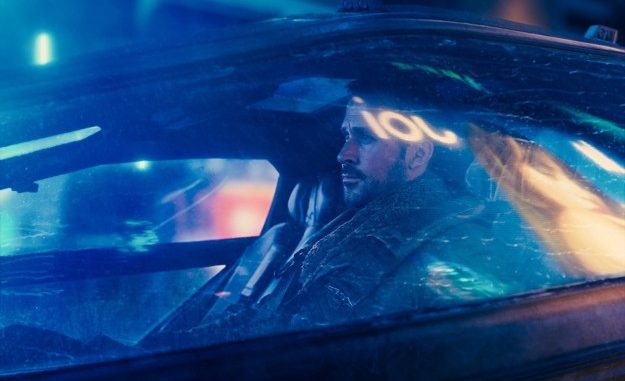
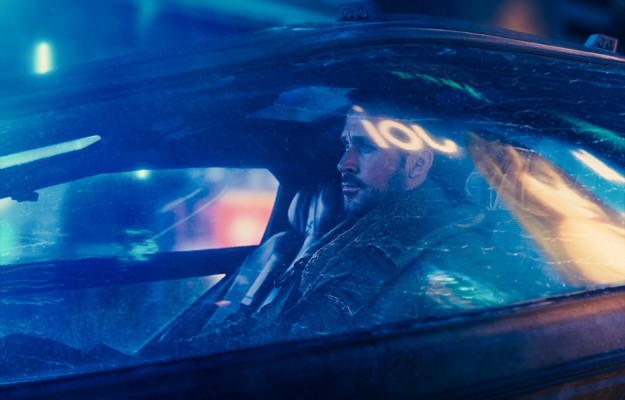
Ryan Gosling in Blade Runner 2049.
Alcon Entertainment / Warner Bros.
Blade Runner 2049’s melancholy hero K, played by Ryan Gosling, has some things in common with his predecessor Rick Deckard (Harrison Ford), protagonist of the original Blade Runner. Like Deckard, K is a loner who likes a long coat, and whose job is to kill — though no one in this dystopian universe calls it that, preferring the euphemism “retire.” K, like Deckard, is a blade runner, a professional hunter of replicants. Unlike Deckard, whose origins were famously left ambiguous in Ridley Scott’s 1982 film, K knows his nature exactly: He’s a replicant himself, and the targets he retires are his own kind — though older, wayward models who’ve attempted to escape the subservient existences for which they were created.
K is part of a new, more obedient line of replicants, synthetic beings primarily invented to bear the brunt of the dangerous labor of space colonization, the fruits of which are then enjoyed by humans who get to start anew in nicer off-world climes. The prime mindfuck of the Blade Runner universe is that replicants are so close in every way to humans that — superhuman strength aside — there’s no way to immediately tell them apart. In the first Blade Runner, a haunting test has been formulated in order to suss out who’s human and who’s not by highlighting the uncanny valley of a replicant’s not-quite-right emotional responses (they are, to quote their corporate manufacturers, “more human than human”).
By the year 2049, in the sequel, all K needs to do is check for a serial number embedded in the sclera of every replicant’s left eyeball. The opening sequence, in which he travels to a protein farm to retire Sapper (played by Dave Bautista), who’s been passing as human, makes it clear that this is easier said than done.
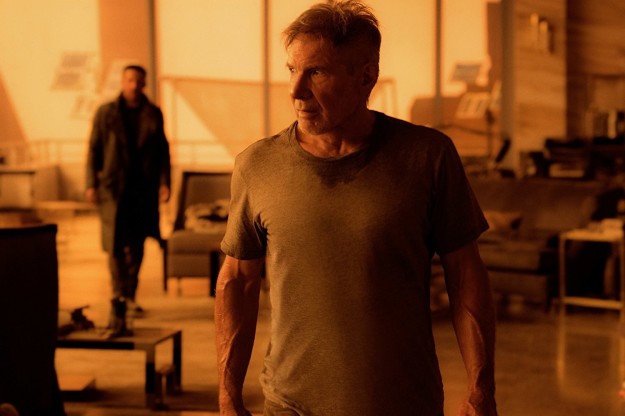
Harrison Ford
Stephen Vaughan, Alcon Entertainment / Warner Bros.
Replicants, as K puts it, don’t have a soul — though as his flinty boss Lieutenant Joshi (Robin Wright) snaps when he uses the word: “You’ve been getting along fine without one.” So it’s maybe appropriate, if disappointing, that Blade Runner 2049 doesn’t have a soul either. Like its main character, the film (very loosely adapted from Philip K. Dick and directed by Denis Villeneuve from a script by Hampton Fancher and Michael Green) coasts along perfectly well without one, until its cavernous hollowness becomes unignorable. The new Blade Runner is a gorgeous simulacrum of a meaningful movie, one that’s even more beautiful, if so much less resonant, than the classic in whose footsteps it follows. The best thing about it is the return to one of cinema’s most memorable and influential landscapes: a near-future Los Angeles on a dying Earth from which everyone fortunate enough has already left.
That LA, vast and dense, is the most compelling character Blade Runner 2049 has to offer, more interesting and more engaging than any of the people, familiar or new, replicant or human, who make their way onto the screen. The film, shot by Roger Deakins, is strenuously dazzling to look at, presenting detailed panoramas of an urban setting made up of dark, jam-packed blocks studded with the occasional pyramid-like mega-skyscraper. The visuals of the sequel are sharper and more self-consciously designed than the original, but the conceptualizing of that forward-tiling LA remains fascinating, the urban equivalent of a garden that’s been allowed to grow wild and untended for years.
It’s a city as a globalized, hypercapitalist hallucination, loomed over by buildings emblazoned with glowing brand names, signage more often in Cyrillic or katakana than English. Ads project holograms towering 40 stories high over packed streets teeming with vendors offering everything from black-market object analysis to automat food to sex. The expanded view presented in Villeneuve’s film includes San Diego as a garbage dump so substantial that it’s home to its own community of trash pirates, and also a giant wall that has been built to keep out an encroaching ocean boosted by rising sea levels. It’s too lived-in a future to feel alarmist — it’s our world, but worse, but also so alluringly cinematic.
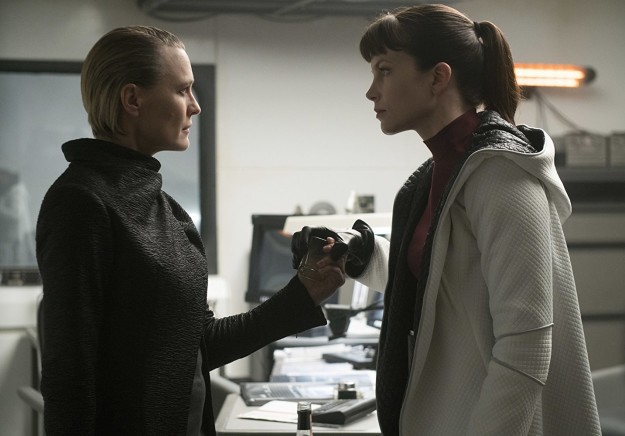
Robin Wright and Sylvia Hoeks.
Stephen Vaughan, Alcon Entertainment / Warner Bros.
The existence K has carved out for himself in this urban sprawl beset by endless precipitation is a lonesome one. The presence of new-model replicants like him are apparently tolerated but disliked by the Earth’s remaining humans — he’s sneered at by his neighbors, and his non-replicant coworkers within the worn confines of the LAPD headquarters have a tendency to use the slur “skin-job” in his presence (then remember and apologize).
The only company K keeps is an AI companion named Joi (Ana de Armas), a biddable holographic fantasy who adores him with a unquestioning wholeheartedness that’s clearly her big selling point but, to us, is still disturbing. She sometimes disturbs K, too: “I’m so happy when I’m with you,” she croons to him; “You don’t have to say that,” he tells her, aware that she, in her computer-mandated ardor, is as compliant with his desires as he is with the humans’.
The uneasy scenes with Joi — this computerized receptacle for longing in the form of a beautiful, incorporeal woman — are K’s most intriguing. His character otherwise comes across as just a still point in an intensely art-directed world. Gosling plays K like a wan variation on the type of roles directors like Nicolas Winding Refn (in Drive and Only God Forgives) and Derek Cianfrance (in Blue Valentine and The Place Beyond the Pines) like to give him — emblematic of a certain kind of romanticized masculinity, stylish and self-sacrificing and sad-eyed, hardboiled exterior with a gooey sentimental core.
And mostly functional, in this case — K questions his own existence, and his search for a purpose coincides with his execution of an assignment which eventually leads to him meeting up with Deckard. But not until after a long, long stretch that’s not meditative: It’s patience-testing. By that time, K’s gone from being the apparent key to the movie to its biggest piece of narrative baggage, a figure who looks great in that shearling duster but is an exasperatingly colorless presence.
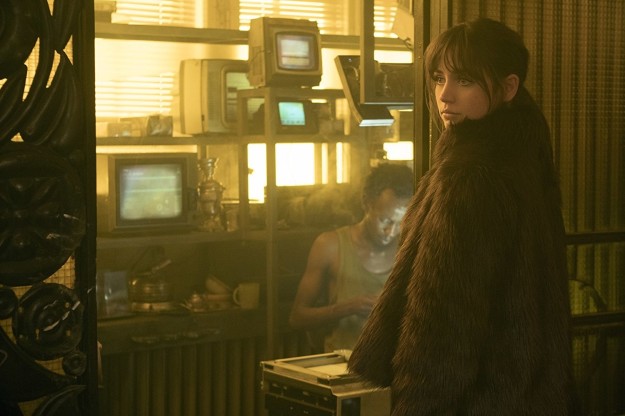
Barkhad Abdi and Ana de Armas.
Stephen Vaughan, Alcon Entertainment / Warner Bros.
And the rest of the film looks so vivid, from the golden lighting that pools around K and sinister fellow replicant Luv (Sylvia Hoeks) as they walk the Wallace Corporation halls to the glowering loiterers K must stride past in the cluttered halls of his own apartment building. The imagery of Blade Runner 2049 has a resonant grandeur the rest of the film can’t come close to matching. It tries, primarily with Jared Leto, whose appearances as blind industrialist Niander Wallace are mercifully brief. Wallace’s theatrical speeches about space expansion and how civilizations move forward are the movie’s equivalent of Rutger Hauer’s “tears in the rain” monologue from the original, and while they include verbiage that plays into the film’s religious parallels, they come nowhere near that splendid conviction, that pulpy power. They’re just Leto muttering about angels on his Zen island of a conference room, all surface and nothing there.
Which is the case for all of the film. It’s exquisite-looking and distant, inviting you into a painstakingly crafted world but no further — certainly not into any particular investment in K, or Joi, or Joshi, or even its older and embittered Deckard, whose presence is still easily the warmest to the touch of anyone onscreen. Ford’s character wasn’t necessarily sympathetic in the first Blade Runner, but he was one whose fate felt important, an individual trying to survive in a system run by giant, indifferent institutions, unwilling to consider the question of whether he himself was just a tool created by one of them. He was someone whose limited point of view was forcefully cracked open. Blade Runner 2049, on the other hand, manages to be prettier but far more prosaic. It might put on a convincing face, but you couldn’t ask it to pass a Voight-Kampff test.

